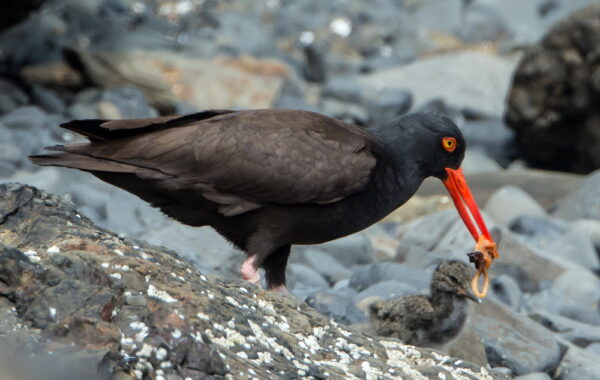Nearshore Ocean
Marine reserves and marine protected areas are places of beauty and wonder–they are also important tools for conserving ocean resources

Thank you for helping pass HB 4132 to support our Marine Reserves!
Take Action! Oregon’s Marine Reserves and Protected Areas are coastal treasures, our state’s only fully protected ocean areas supporting climate resilience, species and habitat conservation. These living laboratories are underwater parks that connect conservation, science, research and communities with the management of our ocean resources.
Unfortunately, Oregon’s legislative budget for ODFW, which administers the Marine Reserve Program, has made significant cuts to the program’s budget and staffing. Further, the 2023 Marine Reserve decadal science and social review calls for increased investments in these specific areas to support community engagement and resilience to climate change stressors in our ocean.
These budget cuts threaten the program, the science and monitoring and the very existence of these ecologically significant ocean places – Oregon’s Marine Reserves and Protected Areas are legacies that must be protected – we need your help to take action in support of these special places before they are lost!
Conservation, Research, Education
Marine Reserves are protected areas of the nearshore ocean where limits are placed on human activities to conserve marine resources. Oregon’s marine reserves are dedicated to conservation, research, and public education. This designation restricts the removal of marine life, preventing fishing, seaweed harvest, mining and other extractive activities, and any uses that would degrade or alter the marine environment.
Our reserves serve as refuges where fish and other marine life are safe from harvest and thus are able to help populations of fish recover from harvest elsewhere, leading to benefits for marine biodiversity and ocean health. Because they are undisturbed, marine reserves are extremely valuable as scientific study sites which can help researchers better understand the effects of ocean conditions on marine life without additional human factors Marine reserves have become an important management tool worldwide in helping to conserve and restore marine resources. These reserves also support public education about marine biology and conservation.

The Reserves
There are five officially designated "no-take" marine reserves off the Oregon coast. Additional Marine Protected Areas (MPAs) have been designated adjacent to all the reserves (except Otter Rock), which restrict but don’t entirely prohibit fishing.
-
Redfish Rocks
The Redfish Rocks Marine Reserve, established in 2012, is positioned between Rocky Point and Coal Point, just south of Port Orford. This area includes a Marine Protected Area to the west.
-
Otter Rock
The Otter Rock Marine Reserve is on the central Oregon coast, near the unincorporated town of Otter Rock. As Oregon’s smallest marine reserve, it spans 1.2 square miles and was established in 2012.
-
Cape Perpetua
Oregon’s largest marine reserve is the Cape Perpetua Marine Reserve, established in 2014 between Yachats and Florence on the central Oregon coast. This area comprises a marine reserve, two Marine Protected Areas, and a Seabird Protection Area.
-
Cascade Head
The Cascade Head Marine Reserve is located off the central Oregon coast, stretching between the Cascade Head headland and Lincoln City. The site includes a marine reserve surrounded by three Marine Protected Areas and was established in 2014.
-
Cape Falcon
Established in 2016, the Cape Falcon Marine Reserve is the northernmost reserve, just off of Oswald West State Park, near Manzanita. This site includes a marine reserve plus two Marine Protected Areas.
Establishing Protection
Oregon Shores played a key role in helping to establish these marine reserves.
Oregon Shores began championing the idea of marine reserves in the early 2000s when we founded the Oregon Ocean coalition with Surfrider and Portland Audubon. Over time, Oregon Ocean morphed into Our Ocean, a long-running campaign involving a more comprehensive range of conservation groups backed by the Pew Foundation, among other foundation supporters. Many others were involved in establishing reserves, including marine scientists, state and federal agencies, ocean users, and other stakeholders.
In 2008-2009, the Oregon Department of Fish and Wildlife and the Department of Land Conservation and Development tasked the Ocean Policy Advisory Committee with leading a community-based process to identify up to nine marine reserve sites. This process led to the designation of Redfish Rocks and Otter Rock marine reserves in 2009 and the subsequent designation of Cascade Head, Cape Falcon, and Cape Perpetua marine reserves in 2011.

Next Steps
Having succeeded in pushing through these first five reserves, our Ocean disbanded. In its place, a coalition of conservation organizations, including Oregon Shores, Surfrider, The Nature Conservancy, Portland Audubon, Oceana, and the Coast Range Association, formed the Oregon Marine Reserves Partnership (OMRP) to keep watch over the management of the reserves, build grassroots support for them through education, advocate for needed research, and stand ready to guard the reserves against any political effort to eliminate or de-fund them. Those efforts continue and are a critical Oregon Shores commitment.
Inspired by the OMRP, a network of local organizations, each devoted to one of the reserves, has sprung up. These groups engage the public, provide educational programming, and serve as stewards for the reserves.
We continue to build public support for the reserves and seek to persuade the legislature to fund them adequately. Our reserves are part of a global effort to protect 30% of the Earth’s land and ocean by 2030 to counter the rapid loss of biodiversity and climate change. To continue the momentum, we aim to inspire widespread support for our marine reserves.

Help us protect the Oregon coast.
MORE ABOUT OUR WORK
